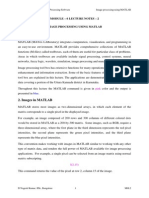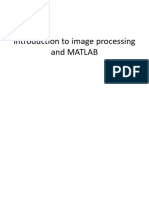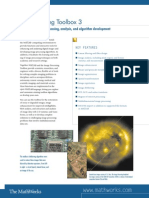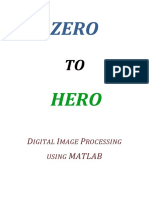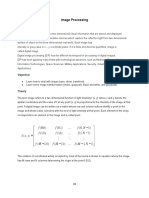Image Processing System Using MATLAB-based Analytics
Uploaded by
Aji MantoroImage Processing System Using MATLAB-based Analytics
Uploaded by
Aji MantoroImage Processing System Using MATLAB-based Analytics.
Ajimantoro1, Anung Priyanto2
Departemen Teknik Elektro, Fakultas Sains dan Teknologi, Universitas Al Azhar Indonesia, Jakarta, Indonesia,
Email : mantoro.aji40@gmail.com, anungpriyanto89@gmail.com
Abstract—This paper presents an efficient image processing steps are involved in image processing which are step as
system built on MATLAB, specifically designed for advanced shown in figure 1, there are edge detection, Fourier transform,
analytics. Leveraging the extensive capabilities of MATLAB, the and enhancement [4].
system performs preprocessing tasks such as filtering and
restoration to optimize image quality. The core of the system lies
in the application of MATLAB-based analytics techniques,
including statistical analysis, pattern recognition, and machine
learning, enabling robust tasks such as object detection and
image classification. A user-friendly interface is provided,
facilitating visualization, customization, and seamless Figure 1 The block diagram of 2D an image processing technique
interaction with the processed images. Experimental
evaluations demonstrate the system's effectiveness in various
II. LITERATURE REVIEW
image analysis scenarios, highlighting its flexibility and
scalability. With its comprehensive toolbox and versatility, this A. MATLAB
MATLAB-based image processing system serves as a valuable
tool for researchers, practitioners, and developers working in
MATLAB is a high-performance language for technical
the field of image processing and analytics. computing. Its integration computation, visualization, and
programming in an easy-to-use environment where problems
Keywords— Digital image filtering, MATLAB, Algorithms, and solutions are expressed in familiar mathematical notation.
Discrete cosine transforms, Image Processing Typical uses include:
I. INTRODUCTION • Math and Computation
The basic definition of image processing refers to • Algorithm Development
processing digital images, i.e removing the noise and any kind • Modelling, Simulation, and Prototyping
of irregularities present in an image using a digital computer.
The noise or irregularity may creep into the image either • Data analysist, exploration, and visualization
during its information or during transformation. Pixel is the
most widely used term to denote the elements of digital image. • Scientific and engineering graphics
Various techniques have been developed in image processing • Application development including graphical user
during the last four to five decades. Most of the techniques are interface building.
developed for enhancing images. Image processing is
becoming popular due to easily availability of powerful MATLAB is an interactive system whose basic data
personal computers, large devices memory, graphic software, element is an array that does not require dimensioning. This
etc [1]. Digital image is a computer system, at times known as allows you to solve many technical computing problems [5].
an image analysis system which has appropriate software and B. Discrete Cosine Transform (DCT)
hardware to manufacture data. Several software systems
available commercially have been created specifically for The discrete cosine transform (DCT) is a technique for
remote sensing image analysis and processing [2]. Image converting a signal into elementary frequency components. It
processing technique has become more relevant in our daily is widely used in image compression. The rapid growth of
lives as it has great impact and applications in technical field digital image application has the need for effective and
exploiting different types of electronic devices. standardized image compression technique [6]. The basic
function of DCT is to transform signals from the spatial
Although digital images can be procedure by exploiting representation into the frequency representation. Starting from
different image processing applications running in several 2006, Chen et al suggested a slight modification on Discrete
physis and software devices. MATLAB-based image Cosine Transform (DCT) algorithm to improve the result
processing can be exploited to give the desired quality suitable performance under large illumination variations. The
for a two-dimensional image. MATLAB is a high-level advantages using the DCT techniques are:
programming language with desirable features that are
fundamental to both the computing and engineering • The DCT is real-valued instead of complexity
disciplines with algorithms that have potential for a wide • The DCT is more efficient for illumination variation.
range of applications [3].
• The DCT Approach is like homomorphic filtering,
This paper presents an image processing technique using which has been used for contrast enhancement [7].
MATLAB-based analysis. Compared to the traditional and
state-of-the art image processing technique and application.
MATLAB gives the several advantages, for instance,
MATLAB easily provides implementation and algorithm
testing without recompilation as well as debugging with
extensive data analysis and visualization. Basically, three
XXX-X-XXXX-XXXX-X/XX/$XX.00 ©20XX IEEE
III. SYSTEM DESIGN IV. RESULT AND ANALYSIS
For determining the system design, need to make a flow In this section we present the performance of MATLAB-
chart to facilitate the system of image processing using based image processing techniques using various algorithms
MATLAB. The flow chart consists of two parts, the first in MATLAB. There are 2 things that we will try to analyze,
convert the original color image to grayscale. The second is to namely the process of converting images to grayscale and
convert the original to RGB Color. converting original images to RGB colors.
A. Flow Chart Convert to grayscale.
A.Convert to Grayscale.
To convert a color image into a gray image, we can
change it through the MATLAB application, the code is as
follows:
%read image
imageFilePath = 'balloons.tif'; % for photos can be
changed ('autumn.png' ,student.jpg’ )
f = imread(imageFilePath); %convert to grayscale
image
f_gray = rgb2gray(f);
%Piecewise Linear Transformation for gray-
increase level
p0 = 0 ;p1 = 20;p2 = 100;p3 = 255;
q0 = 0; q1 = 30;q2 = 200;q3 = 255;
s1 = (q1 - q0) / (p1 - p0);
t1 = q0 - s1 * p0;
s2 = (q2 - q1) / (p2 - p1);
t2 = q1 - s2 * p1;
Figure 2 Flow chart convert Original to grayscale color.
s3 = (q3 - q2) / (p3 - p2);
The program starts by reading the image from specified t3 = q2 - s3 * p2;
file (step: read image), and then image will be saved in
specified variable, and then saved into matrix. After that, the g = mat2gray(f_gray);
picture will be converted to grayscale with some function. The
picture of grayscale will be saved into variable. After that the for i = 1:size(g, 1)
picture will be transformed into linear piecewise to increase for j = 1:size(g, 2)
the grayscale. And the last the output will appear with the p = g(i, j);
color gray. if (p >= p0) && (p < p1)
B. Flow Chart Convert to RGB Value g(i, j) = s1 * p + t1;
elseif (p >= p1) && (p < p2)
g(i, j) = s2 * p + t2;
elseif (p >= p2) && (p <= p3)
g(i, j) = s3 * p + t3;
end
end
end
%Output Image
figure, imshow(g);
title('Output Increase Image Grayscale');
The image output generated from the MATLAB program
above is as follows:
Figure 3 Flow chart convert Original to RGB color.
The program starts by reading the image from specified
file (step: read image), and then image will be saved in
specified variable, and then saved into matrix. After that, the
picture will be converted to R (red), G (green), B (blue) with Original image Gray Scale Image
the detail, for R area take the Red value than compile with R,
G0, B0. G0, and B0 it means green, and blue are 0 color so,
Figure 4. Result the grayscale image processing
the color on the picture will be Red. And, that parameter for
green and blue color.
For others trials we can also change the parameter in the
MATLAB code to know the best code for processing images
into grayscale. We can change the code in sub %Piecewise
Linear Transformation for gray- increase level on the
MATLAB. For the results as follows:
Original image Red image
Green image Blue image
Figure 7. Result the RGB image processing
V. CONCLUSION
Figure 5. Result trials the grayscale image processing
In the MATLAB code, the larger the value of the piecewise This research Image Processing System Using
parameter, the darker the color changes. The figure 5 shows several MATLAB-based Analytics. This research also presents an
variations in the piecewise parameters ranging from the smallest empirically based model that uses an image processing
value of 0 to 255. The trial results indicate that the best parameters
application with features derived from DCT coefficients. The
for achieving a good grayscale composition are p0 = 0, p1 = 20, p2
system is evaluated in MATLAB. This research aims to
= 75, and p3 = 125. And we can try various image formats such
provide the readers with various image processing
as jpg, for the results of several images with jpg and png
applications running on MATLAB platform and to provide a
formats that we have done the following experiments using
wider knowledge to the researchers about MATLAB based
the composition p0 = 0, p1 = 20, p2 = 75, and p3 = 125 :
image processing techniques that can be exploited for some
- JPG format image
specific applications. With different algorithms run with
MATLAB, we simulated how to convert an image to gray, and
can also convert an image based on the basic colors of red,
green and blue. With MATLAB, the various steps used for
image processing can be well documented and replicated.
REFERENCES
Original image Gray Scale Image
Figure 6. Result the grayscale image processing PNG format. [1] B Chitradevi, P. S. (2014). An Overview on Image Processing
Techniques. International Journal of Innovative Research in
B.Convert to RGB. Computer, 1.
[2] Hongmei Zhang, Z. P. (2015). Design and Implementation of Image .
International Conference on Logistics Engineering, Management and
To convert a color image into an RGB (Red, Green, Computer Science (LEMCS 2015), 2.
Blue) image, we can change it through the MATLAB [3] ongmei Zhang, Z. P. (2015). Design and Implementation of Image .
application, the code is as follows: International Conference on Logistics Engineering, Management and
%read image Computer Science (LEMCS 2015), 2
I = imread('balloons.tif');% for photos can be [4] Mahmud S. Mohammed J. Hasan Muaidi, S. M. (2014). A Survey of
Digital Image Processing Techniques in Character . IJCSNS
changed ('autumn.png' ,Student.jpg',ext ) International Journal of Computer Science and Network Security,
R = I(:,:,1); VOL.14 No.3, March 2014, 1
G = I(:,:,2); [5] Mustafa, W. A. (2019). Image Enhancement Based on Discrete Cosine.
B = I(:,:,3); IOP Conference Series: Materials Science and Engineering, 3
%convert image [6] Watson, A. B. (1994). Image Compression Using the Discrete .
Red = cat(3,R,G*0,B*0); Mathematica Journal, 4(1), 1994, p. 81-88, 2.
Green = cat(3,R*0,G,B*0);
Blue = cat(3,R*0,G*0,B);
%Output image
figure, imshow(I);
figure, imshow(Red);
figure, imshow(Green);
figure, imshow(Blue)
The image output generated from the MATLAB
program above is as follows:
You might also like
- Digital Image Processing Using Matlab: Haris Papasaika-Hanusch Institute of Geodesy and Photogrammetry, ETH ZurichNo ratings yetDigital Image Processing Using Matlab: Haris Papasaika-Hanusch Institute of Geodesy and Photogrammetry, ETH Zurich63 pages
- Digital Image Processing Using MATLAB 4th Edition Rafael C. Gonzalez - Own the complete ebook set now in PDF and DOCX formatsNo ratings yetDigital Image Processing Using MATLAB 4th Edition Rafael C. Gonzalez - Own the complete ebook set now in PDF and DOCX formats79 pages
- Basics of Image Processing in Matlab Lab File PDFNo ratings yetBasics of Image Processing in Matlab Lab File PDF86 pages
- MATLAB Excercise For Image Processing IINo ratings yetMATLAB Excercise For Image Processing II6 pages
- An Implementation and Design A Customized Advanced Image Editor Using Image Processing in MatlabNo ratings yetAn Implementation and Design A Customized Advanced Image Editor Using Image Processing in Matlab5 pages
- Introduction To Image Processing in MATLABNo ratings yetIntroduction To Image Processing in MATLAB4 pages
- Merging Images Using Matlab: S.Triaška,-M.Gažo Institute of Control and Industrial InformaticsNo ratings yetMerging Images Using Matlab: S.Triaška,-M.Gažo Institute of Control and Industrial Informatics5 pages
- Digital Signal Processing by Luigi De RealNo ratings yetDigital Signal Processing by Luigi De Real9 pages
- Introduction To Digital Image Processing Using MATLABNo ratings yetIntroduction To Digital Image Processing Using MATLAB35 pages
- Digital Image Processing Technology Based On MATLAB100% (1)Digital Image Processing Technology Based On MATLAB4 pages
- Matlab Software Package For Image Processing and AnalysisNo ratings yetMatlab Software Package For Image Processing and Analysis32 pages
- Syllabus IT3061 Image Processing Credits:4 Teaching Scheme: 3 Hours / Week Lab: 2 Hours / WeekNo ratings yetSyllabus IT3061 Image Processing Credits:4 Teaching Scheme: 3 Hours / Week Lab: 2 Hours / Week3 pages
- Digital Image Processing Using MATLAB: J.Nageswara Rao, M.Veerraju, Mca 2 YearNo ratings yetDigital Image Processing Using MATLAB: J.Nageswara Rao, M.Veerraju, Mca 2 Year24 pages
- Specific Color Detection in Images Using RGB Modelling in MatlabNo ratings yetSpecific Color Detection in Images Using RGB Modelling in Matlab5 pages
- Experiment 9: The DTFT of A Sequence X (N) Is Defined by FollowingNo ratings yetExperiment 9: The DTFT of A Sequence X (N) Is Defined by Following7 pages
- MIP-Lab-Manual-BM3652-MEDICAL-IMAGE-PROCESSINGNo ratings yetMIP-Lab-Manual-BM3652-MEDICAL-IMAGE-PROCESSING72 pages
- Practical-1: Fundamentals of Image ProcessingNo ratings yetPractical-1: Fundamentals of Image Processing8 pages
- Image & Vision Toolbox For Matlab V7.3 PDFNo ratings yetImage & Vision Toolbox For Matlab V7.3 PDF10 pages
- Digital Image Processing Using MATLAB 2nd edition Edition Rafael C. Gonzalez - Download the ebook now to start reading without waiting100% (2)Digital Image Processing Using MATLAB 2nd edition Edition Rafael C. Gonzalez - Download the ebook now to start reading without waiting47 pages
- Color Mapping: Exploring Visual Perception and Analysis in Computer VisionFrom EverandColor Mapping: Exploring Visual Perception and Analysis in Computer VisionNo ratings yet
- Excel Formulas and Functions - For Complete Beginners, Step-By-Step Illustrated Guide To Master Formulas and Functions - William B. Skates100% (5)Excel Formulas and Functions - For Complete Beginners, Step-By-Step Illustrated Guide To Master Formulas and Functions - William B. Skates108 pages
- VMware Vsphere 6 Standard, Enterprise, Enterprise PlusNo ratings yetVMware Vsphere 6 Standard, Enterprise, Enterprise Plus4 pages
- Universal Verification Methodology Based Verification Environment For PCIE Data Link LayerNo ratings yetUniversal Verification Methodology Based Verification Environment For PCIE Data Link Layer5 pages
- Performance Tuning Tips For Stored ProceduresNo ratings yetPerformance Tuning Tips For Stored Procedures12 pages
- Decision Support Systems and Business IntelligenceNo ratings yetDecision Support Systems and Business Intelligence28 pages
- Job Description Opportunity Assesment Mgr-RevNo ratings yetJob Description Opportunity Assesment Mgr-Rev4 pages
- Elektor (Nonlinear - Ir) 1979-09 - TextNo ratings yetElektor (Nonlinear - Ir) 1979-09 - Text57 pages
- Colour Theory and Colour Matching OptionalNo ratings yetColour Theory and Colour Matching Optional2 pages
- CIS Oracle Database 11g R2 Benchmark v2.2.0No ratings yetCIS Oracle Database 11g R2 Benchmark v2.2.0161 pages



